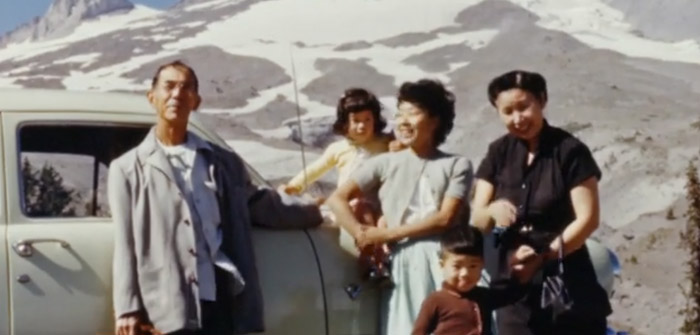(Photo | Courtesy of Oregon Historical Society)
“There’s no such thing as a bad home movie. These mini-underground opuses are revealing, scary, joyous, always flawed, filled with accidental art and shout out from attics and closets all over the world to be seen again.” — John Waters
The Oregon Historical Society is excited to announce that 15 reels of 16mm home movies, shot by the Tsuboi family, are now available for viewing on the Oregon Historical Society Digital Collections website.
Teruo Tsuboi ran, with his older brother, the Tsuboi Brothers store at 315 Burnside Street, Portland. The store sold Western-style clothing, jewelry and, after World War II, added an optometrist exam room. The films document the day-to-day activities of a Japanese-American family living in the Pacific Northwest over multiple generations and contain rare scenes of family life both before and after World War II.
Films include, in part: family visits to the Pendleton Round-Up, drives through the snow in downtown Portland, Rose Festival parades, a Japanese baseball team at Civic Stadium, family members posing near Mt. Hood, trips to and from Japan via ship, a brief glimpse of the ruins of the Minidoka incarceration camp, a trip to Los Angeles in 1931 and various Pacific Northwest vacations and scenes from family life.
The Japanese American Museum of Oregon has been instrumental in identifying and promoting these films. Director of Collections and Exhibits Lucy Capehart notes, “The Tsuboi films provide a magical window into Portland’s past. The films also show that Japanese-Americans have been part of Portland’s social fabric for generations; participating in the Rose Festival parade, riding a bike down a neighborhood street and playing baseball.”
Teruo (1889–1965) and Suma Tsuboi (1889–1977) emigrated from Okayama, Japan, to Portland, Oregon, in the early 20th century. They had four children (called Nisei, or the children of Japanese immigrants born in the United States): Teruhisa “Ted,” Akiko, Sachiko and Kazuko.
When 16mm film first hit the consumer market in the late 1920s, it was available mainly to those who could afford the relatively high cost of film and camera. As 16mm became more affordable, with the added ability to shoot in color, it became the main method of documenting 20th century family life, before being displaced by 8/S8mm, magnetic videotape and digital video.
For more information on efforts being made to preserve the experiences of Asian Americans through home movies, please visit the Memories to Light project by the Center for Asian American Media.
The Center for Home Movies is another great resource that documents the importance of collecting and preserving home movies.
For more information on this collection, please contact: Matthew Cowan, the Oregon Historical Society’s Archivist for Moving Images & Photography, at matthew.cowan@ohs.org.

